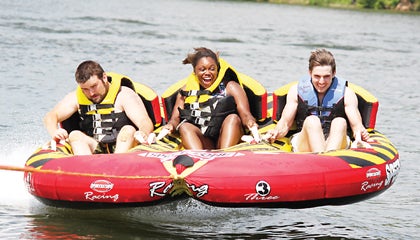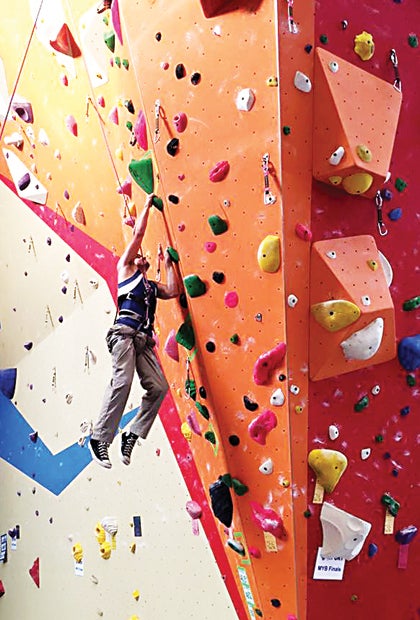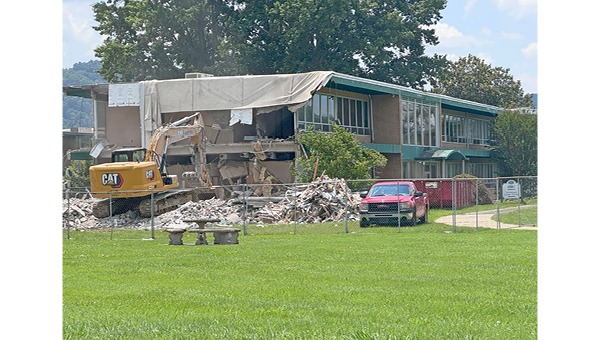Refusing to Give Up: Local man excels in athletics despite loss of function in legs
Published 9:04 am Monday, February 15, 2016

Contributed Photo
In sled hockey, players use a pic in one hand for mobility and the hockey stick in the other to pass the puck. Daniel Smith (pictured) is promoting the sport in Knoxville after playing primarily in Nashville.
Daniel Smith has competed in and won hand cycling marathons and half marathons as well as paraclimbing competitions. Now, the 28-year-old is working to expand a sled hockey team from Nashville to Knoxville. And, he has done all of these things without the use of his legs.
His first attempt at riding a motorcycle at age 22 robbed him of the use of his legs.
“I was trying to learn to ride at Elizabethton High School and to do it safely, but I moved my wrist in a way that made it jump from zero to 70 miles per hour,” Daniel recalled.
Though he doesn’t remember much after that, he said he was thrown into a guard rail, and the bike came down on his legs. That night, his father said Daniel nearly died. For the next 10 days he was in the intensive care unit.

“Before that, I had never broken a bone,” he said. “It broke seven ribs, my left collar bone, the right side of my pelvis and T4 through T12 of my spine.”
Daniel was hospitalized for more than three weeks in April 2010, and then had metal rods placed in his back. He completed spinal rehab, but never regained the function of his legs and said he has no sensation from the waist down.
Unlike some might have done, Daniel drew what he could from the experience and decided to continue leading an active life.
“For me, it wasn’t really a choice,” he said. “I thought, ‘I can lay here and feel sorry for myself, or I can get back to living,’ because I had a lot of stuff I wanted to do, and I still do. I wanted to get back to having fun, so I thought, ‘I’ll make whatever changes I have to and move on.’”
Daniel said his recovery didn’t happen alone.
“My family — immediate and extended — were all extremely supportive,” he said. “The entire family played a very pivotal role in me getting where I am today. They may not take as much credit as they deserve, but they pushed me to keep being me, to keep doing things I wanted to do and to not accept the idea that I couldn’t do something.”
With them, he said the attitude was never to say he could not do something, but always asking “How are we going to make this work so you can do this?”
“Sometimes it’s not been graceful,” he said. “Whether it’s going to rock concerts or movie theaters, having to go down steps or playing sports, they’ve been extremely supportive.”
His father Gary Smith, director of Carter County Emergency Management Agency, said he considers it a miracle that Daniel was selected for physical therapy at the Shepherd Center in Atlanta.
“There were people waiting as much as six months to get in,” Gary said. “The doors just opened. He happened to be in the right place at right time.”
While there, doctors did an evaluation, at which time they determined he would not be able to do therapy, due to his broken clavicle. “The doctor said he was going to have to send him home, and that they would try to get him back in, but the reality was that it probably wouldn’t happen,” Gary said. “Daniel said he wanted to finish therapy, so the doctor directed him to see what he could do or not do, and if he could complete therapy, he would be allowed to stay. That’s another miracle. I don’t know how he did it with a broken clavicle; he’s a pretty amazing young man.”
After 44 days at the Shepherd Center, he was released. “There are no words to describe how strong he’s been,” Gary said. “He could not even sit up by himself when he went in; 44 days later, he was able to drive and live by himself — that’s one of the reasons he’s able to do the things he does now.”
While at the Shepherd Center, he learned to do adaptive skiing with the Patricia Neal Rehabilitation Center and attended the annual Adventure Skills Workshop in Alabama, where he learned how to scuba dive, rock climb, ride a jet ski, and go tubing. Gary said it is also the organization that introduced him to wheelchair rugby.
“He loves it, and it is absolutely brutal,” Gary said of rugby. “That’s what really got him rolling is therapy recreation programs. They take folks and show them what they can do.”

Gary said they now go every year and he gets to see Daniel do things that he and the family never dreamed he would be able to do.
Before his accident, Daniel said he was always active in running and playing intramural sports. He said hand cycling, a style of hand-pedalled tricycle, has replaced running because of the similarity in competitions. Additionally, he is an active paraclimber, which is an adaptive style of rock climbing.
In October, he began playing sled hockey, a sport with the same rules as hockey except in regards to the way players may hit one another. The sport accommodates paraplegic athletes because they play from a sled which conforms to the body of the player, providing stability, mobility, and ability to turn sharply. They move across the ice with a pic in one hand and pass the puck with a standard hockey stick in the other.
Daniel has to travel to either Nashville or Knoxville to play, as there are no closer ice rinks, and renting of the rink is not cheap, he said. Despite the distance, he and a few friends in the Nashville league are working on establishing a regular team in Knoxville.
The two adult teams and one youth team in Nashville recently competed against teams from Carolina, Florida and Georgia, and Daniel said these competitions and teams are an excellent way to meet people.
One woman on his sled hockey team was on the Paralympic hand cycling team and won Nationals in rock climbing. Another man is a world-traveling push-rim racer.
“Sled hockey is probably the most inclusive sport I’ve ever played because you can be double amputee, paraplegic or single amputee, and you can have up to three able-bodied athletes,” said Daniel, adding only one able-bodied athlete may be on the ice at the time and cannot play goalie.
He plays sled hockey, at least during free skate time, once a month with his friends and said they go to Nashville at least twice monthly.
On top of that, he climbs in Knoxville once a month and said he tries to climb at the East Tennessee State University wall once a week.
“I didn’t really climb before the accident, but the founder of Catalyst Sports talked me into trying it,” Daniel said. “I wish I would have done it before.”

He said the staff at ETSU set a route that accommodates arm-only climbing, leaving out some of the tiny foot holds that are not intended for hands.
Of all the sports which he is involved in, Daniel has the most experience in hand cycling. He has done a Beast Series race, consisting of five half-marathons (13.1 miles each), twice. He hand cycled in the Knoxville Marathon, Haunted House Half Marathon, BAE Veteran’s Day Marathon, Bluegrass Half Marathon, and others, with a best half marathon time at an hour and five minutes.

“I’m wanting to cut that time down,” Daniel said. “I probably could have broken under an hour if I hadn’t stopped but the one guy I raced with had mechanical issues, so since it was just me and him in the race, I stayed with him to make sure he was able to get going.”
Not only did he compete, he won two races just last year in which he had competitors. He said the high cost of the cycles — at around $2,000 — turns some people off to the sport. An organization that helps get people involved, Challenge Athletes, helped him to purchase his, for which he said he was very grateful.
On top of being involved in more sports than the average person with the function of legs, he works full time as a computer programer at ETSU. Though the accident has had a major impact on both his life and the lives of his family members, he said it has made him more thankful for the things and people he has in his life.
“I would say this made us more appreciative of what we do have, because you can’t quite understand that until it happens,” Daniel said. “It’s kind of unfortunate that that’s how I had to learn it, but it wasn’t really a choice.”
Now, Daniel uses his accident to teach about adapting his lifestyle to accommodate spinal injury with occupational therapy students at Milligan College as well as with physical therapy students at ETSU.
“Hearing it from a person who is experiencing it and who can detail the ins and outs, is received differently than when they read it in a textbook,” Daniel said. “It gives it a more human element.”





